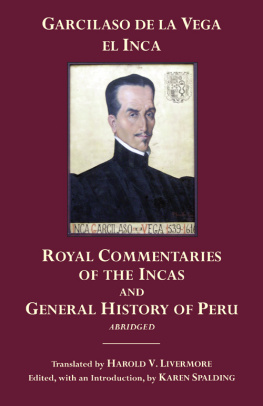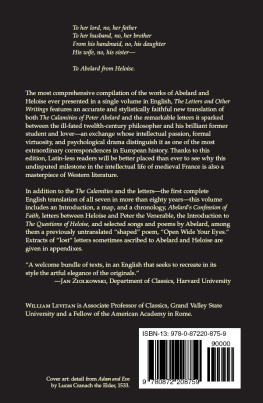Persian Letters.
Alzire.
He was called Yahuarhuocac, which meant literally, Weeps-Blood.
Volume v, chapter 6, On carriages.
See Religious Ceremonies and Customs. Dissertations on the Peoples of America. Chapter 13.
The Quipos of Peru were also in use among other peoples of Southern America.
Caciques, a kind of provincial governor.
Rulers of a small region; they never appeared before Incas and their wives without bringing them an offering of the local produce from the province where they ruled.
Puffendorf, Introduction to Hist.
Extracts from the marquise de Lamberts Advice from a Mother to her Daughter are to be found in Appendix 4.
Extracts from a seventeenth-century English translation of the Royal Commentaries are to be found in Appendix 1.
Extracts from both these works are to be found in Appendix 2.
Published in 1749 in his journal Lettres sur quelques crits de ce temps.
The abb Joseph de La Porte (1714 79), journalist and close collaborator of Frron. His review appeared in 1749, in his periodical Observations sur la littrature moderne.
The abb Raynal (1713 96) was a regular at Graffignys salon. He contributed to the Encyclopdie, and his polemical history of colonization in Asia and the Americas, the Historyof the Two Indies (1770 80), on which he collaborated with Diderot and others, would make his name and his fortune. His review of Graffignys novel first appeared in the manuscript periodical, Nouvelles littraires.
Extracts from both these English continuations are to be found in Appendix 3.
Name of Thunder.
A large number of short strings of different colours which the Indians, who had no system of writing, used to calculate payments to their troops, or the number of their population. Some authors claim that they also used them to record for posterity the memorable deeds of their Incas.
In the Temple of the Sun there were one hundred doors which only the Inca had the power to have opened.
Something like Governesses of the Virgins of the Temple.
The generic name for the ruling Incas.
Virgins dedicated to the Sun entered the Temple almost at birth and left only on the day of their marriage.
Messenger.
The God Creator, more powerful than the Sun.
Philosophers of the Indies.
The Diadem of the Incas was a type of fringe. It was the work of the Virgins of the Sun.
The ruling Inca alone had the right to enter the Temple of the Sun.
Priests of the Sun.
One Virgin was chosen by the Sun, who should never be married.
The laws of the Indians obliged the Incas to marry their sisters, and, if they had none, to take for a wife the first Princess of the Blood of the Incas who was a Virgin of the Sun.
It was regarded as axiomatic that a Peruvian had never lied.
The Indians believed that the end of the world would be brought about by the Moon falling to the earth.
The Indians believed that after death, the soul entered unknown regions where it would be rewarded or punished according to its deserts.
Cacique is a kind of provincial Governor.
The Indians had no knowledge of Medicine.
The Raymi, principal festival of the Sun; the Inca and the Priests worshipped the Sun on their knees.
The Great Name was Pachacamac, it was spoken only rarely, and with many signs of veneration.
They kissed the Diadem of Manco-Capac, as we kiss the Relics of our Saints.
Mas is a plant from which the Indians make a potent, wholesome brew; they present it to the Sun on its festival days and they partake of it to the point of drunkenness after the sacrifice. See the History of the Incas, volume ii, page 151.
The Indians did not know our hemisphere, and believed that the Sun shone only on the land of its children.
Servant or maid.
Capital of Peru.
Land was cultivated by the whole community in Peru and the days of this work were days of rejoicing.
The Curacas were the minor rulers of a Country; they had the privilege of wearing the same robes as the Incas.
The generic name for Princesses.
A generic term for animals.
The beds, chairs, and tables of the Incas were made of solid gold.
Young girls, even those of royal blood, bore great respect for married women.
Prince of royal blood: permission was needed from the Inca to wear gold on ones clothes, and this was only given to Princes of royal blood.
Caciques and Curacas were obliged to provide the clothing and the provisions of the Inca and the queen. They never appeared before either one without offering them as tribute a gift of the produce particular to the province over which they ruled.
This is the name taken by Queens on their ascent to the throne.
See the History of the Incas.
The Incas had set up large houses on the roads, where they welcomed travellers without any charge.
A drink of the Indians.
The Incas placed in the Temple of the Sun the idols of the peoples they conquered, having first made them accept the cult of the Sun. They also had idols themselves, since the Inca Huayna consulted the Idol of Rimace. History of the Incas, volume 1, page 350.
The Incas decorated their houses with golden statues of all sizes, even gigantic ones.
The Incas sat only on seats of solid gold.
We have already said that the gardens of the Temple and those of the Royal Houses were filled with all kinds of imitations of nature in gold and silver. The Peruvians even made representations of the grass called Mas, with which they would fill entire fields.
Considerations on the Manners of this Century, by M. Duclos.
Laws dispensed women of all hard physical work.
OXFORD WORLDS CLASSICS
LETTERS OF A PERUVIAN WOMAN
FRANOISE DE GRAFFIGNY was born Franoise dIssembourg dHapponcourt in Nancy on 11 February 1695, the daughter of a prosperous military officer at the court of Duke Leopold of Lorraine. In 1712, she married Franois Huguet de Graffigny, chamberlain to the duke. He was a drunkard, and the marriage was brutal and brief; the couple were separated six years later, and he died in 1725. Mme de Graffigny spent the following years at the court of Lorraine in Lunville, leading an active social and cultural life; she began a passionate relationship with Leopold Desmarest, and met Franois-Antoine Devaux who would become her life-long confidant. She left the court in 1738, and spent two months at Cirey with Voltaire and Mme Du Chtelet. Her stay ended abruptly when she was falsely accused of copying a canto of Voltaires satire The Maid (La Pucelle). Moving to Paris in February 1739, she suffered serious financial hardship, particularly after the death in 1740 of her protectress, the duchesse de Richelieu; she spent the next two years living in a convent as companion to the princesse de Ligne and others. In November 1742, she bought her own house, and became close to Jeanne Quinault, former actress and co-founder of a popular salon which attracted many major figures. Following the end of her relationship with Desmarest in 1743, she began to write, publishing two short stories; an unwise investment, however, increased her financial difficulties. The publication in 1747 of her novel Letters of a Peruvian Woman (Lettres dune Pruvienne) made her famous throughout Europe, a fame confirmed three years later when her sentimental comedy Cnie was a triumph at the Comdie-Franaise. She acquired new and influential protectors, and opened her own salon which became one of the most distinguished of its day. In 1758 her play
Next page









